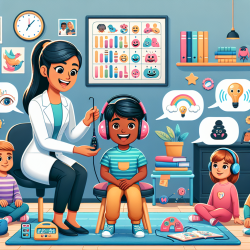Introduction
Perceived racism is a crucial yet often overlooked determinant of adolescent health and well-being. The recent study, "Perceived Racism and Demographic, Mental Health, and Behavioral Characteristics Among High School Students During the COVID-19 Pandemic," highlights the profound impact of racism on students' mental health and behavior. As practitioners in the field of speech language pathology, understanding these dynamics is essential to fostering inclusive and supportive educational environments.
Key Findings from the Study
The study, conducted by the CDC, analyzed data from the Adolescent Behaviors and Experiences Survey (ABES) involving 7,705 high school students. The findings reveal that approximately one-third of U.S. high school students reported experiencing perceived racism. This was notably higher among Asian (63.9%), Black (55.2%), and multiracial students (54.5%). The study also found that students who reported perceived racism had higher incidences of poor mental health (38.1%), difficulty concentrating (44.1%), and not feeling close to others at school (40.7%).
Implications for Practitioners
Understanding these findings can guide practitioners in implementing strategies to improve student outcomes. Here are some actionable steps:
- Promote Cultural Awareness: Develop training programs for staff and students to enhance cultural competence and awareness. This can help in creating a more inclusive school environment.
- Implement Antiracist Interventions: Schools should adopt policies and practices that actively combat racism and promote inclusivity.
- Foster Mental Health Support: Establish support systems for students experiencing mental health challenges related to perceived racism. This could include counseling services and peer support groups.
- Encourage Further Research: Practitioners should advocate for more research into the effects of perceived racism on adolescent health to inform future interventions.
Encouraging Further Research
While the study provides valuable insights, it also highlights the need for further research. Specifically, there is a need to explore the intersectionality of perceived racism with other factors such as socioeconomic status, gender, and sexual orientation. Longitudinal studies could provide deeper insights into the long-term effects of perceived racism on mental health and academic outcomes.
Conclusion
Addressing perceived racism in schools is critical for promoting equitable health outcomes for all students. By understanding the associations between perceived racism and negative health outcomes, practitioners can develop targeted interventions to create safe and supportive school environments. This is not just an educational imperative but a moral one, ensuring every child has the opportunity to thrive.
To read the original research paper, please follow this link: Perceived Racism and Demographic, Mental Health, and Behavioral Characteristics Among High School Students During the COVID-19 Pandemic — Adolescent Behaviors and Experiences Survey, United States, January–June 2021.










